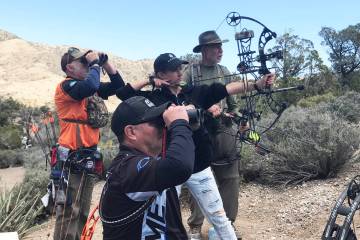Successful quail hunting takes advance scouting
When it comes to big game hunting, there are few hunters who will argue the importance and the value of preseason scouting, especially when one will be hunting in a new area or is looking for an animal boasting a specific class of antler growth or body size.
My nephews, for example, invest considerable time in the scouting process and as a result have documented numerous mature deer and elk while also becoming intimately familiar with the ground the animals live in. This is true even in years when they don’t have a big game tag in their pocket because they enjoy learning as much as they can about the game they pursue and the places they live.
When it comes to hunting small game species like Gambel’s quail, however, many hunters discount the importance of scouting. Perhaps it is because upland birds can sometimes be relatively easy to find if you know where to look and if the habitat is in good condition. But that isn’t always the case, and there is more to scouting than finding the game you seek.
A significant part of scouting involves learning the lay of the land, the location of resources your prey depends on and how they travel between them. It also is the opportunity to become familiar with routes that enable the hunter to move through the area they plan on hunting. Keep in mind that even if you hunt the same areas year after year, travel routes you used in prior seasons may no longer be passable.
That is especially true in the desert where violent thunderstorms can quickly alter the landscape and the roads that pass through it.
Something else to look for is water, both natural and man-made sources. Water is always the key when hunting in the desert, but especially in dry years. Though Southern Nevada enjoyed a very wet winter and spring, we haven’t received much precipitation during the summer months. That means finding water sources should be a starting point in your preseason intelligence gathering activities.
Quail make their way to water in the morning and again in the evening, but keep in mind that it doesn’t take much water to provide for the needs of a small covey of quail. You aren’t necessarily looking for a large volume of water. Even a small leak in a water pipe can meet their needs. If we get some rain in the next few weeks, natural water tanks and even puddles should be on your watch list. The birds can generally be found no more than a mile or so from water.
If you are new to the Mojave Desert, you will want to be familiar with guzzlers. These are man-made devices that trap and store rainwater in underground tanks for the benefit of birds and small mammals. You can quickly discern whether quail are using a guzzler by looking for their tracks in the dust nearby or in the bottoms of washes leading to and from the guzzler.
Don’t forget to take notice of where food sources are located. An adult quail’s diet consists primarily of seeds, grasses and leaves, though they will eat insects during the nesting season. They also will eat cactus fruit and mistletoe berries. Mistletoe can often be found in mesquite stands or acacia bushes.
Fall rains will provide some new grasses that quail seem to favor. If you find some green patches during the hunting season, quail won’t be too far away.
Quail tend to favor country that is a mix of open ground, brush and low growing trees. They don’t spend much time in unbroken grassland that is void of larger plants or shrubs. Brushy draws, both large and small, are good places to begin a search. So too are stands of mesquite trees and acacia bushes. Though they spend most of their time on the ground, they will often be seen in trees or brush.
Sometimes you won’t see birds while scouting, but if you listen closely you might hear them. Quail constantly chatter and can often be heard calling to one another in an effort to gather the covey. Even if you don’t see them, you will know their general location and can come back for a closer look when the season begins.
Freelance writer Doug Nielsen is a conservation educator for the Nevada Department of Wildlife. His “In the Outdoors” column, published Thursday, is not affiliated with or endorsed by the NDOW. Any opinions he states in his column are his own. Find him on Facebook at @dougwritesoutdoors. He can be reached at intheoutdoorslv@gmail.com


















